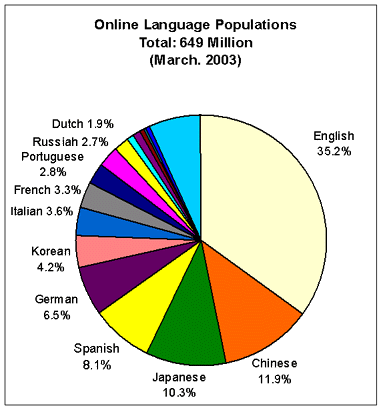International Educators
- About USjournal.com, LLC
- Advertising / Promotional Options
- Advertising Rate Card (pdf)
- Academic Program Listing (pdf)

- Current USjournal.com Advertisers
- Current USjournal.com Services
- Follow USjournal on LinkedIn
- FundsV Named Innovation Finalist
- Growth in Online Language Usage
- Multi-lingual Campaign Advantages
- SkyRadio Audio Segment (wma)
- Strategic Partnership with USDOC

- USjournal.communique
- USjournal History
- USjournal Innovation Lab
| eRecruitment Trends and Techniques for International Admissions: Presented Wednesday, 28 May 2003 | NAFSA Conference | Salt Lake City, Utah |
Session Chair: Carole Cummings, EstudiosUSA.com, award-winning sister site of usjournal.com
Co-Presenter: Jean Frisbie, U.S. Department of State Educational Information and Resources Branch
Questions? Contact Cheryl Darrup-Boychuck, (usjournal.com)
eRecruitment Trends and Techniques' Trivia (Answers at the bottom of this page)
1. Which ethnic group currently represents the largest minority group in the United States, according to a recent Census Bureau report? (nearly 13% of the U.S. population, or 37 million people in July 2001)
a) Hispanics
b) Asians
c) African-Americans
2. What is the ratio of U.S. Hispanics' preference for accessing Spanish-language websites as opposed to English-language websites, according to the latest Roslow Hispanic Internet Usage Study published in January 2002?
a) 55% Spanish :: 45% English
b) 90% Spanish :: 10% English
c) 20% Spanish :: 80% English
3. When comparing U.S. Census Reports from 1990 and 2000, which ethnic population grew by approximately 41 percent, to nearly 12 million people?
a) Asians
b) African-Americans
c) Hispanics
4. Among Asians in the United States, which (broad) native language is the most popular, according to the January 2003 edition of Global Communicator?
a) Chinese
b) Japanese
c) Korean
5. According to the January 2003 edition of Global Communicator, what percentage of Chinese-American internet users visit Chinese-language websites?
a) 73%
b) 17%
c) 45%
6. According to a November 2002 article in Wired News, which country's government employs some 30,000 internet police to monitor its citizens' online activity?
a) China
b) Cuba
c) Russia
7. In mid-March 2003, which country's government announced that it will allow businesses outside of its own country to register domains ending in its two-character country code (such as .us for the United States)? Previously, the rules of registration were much more stringent.
a) China
b) Turkey
c) Paraguay
8. Name two countries in Asia, documented as the top users of e-commerce (according to Global Reach, May 2003):
a) Singapore and Taiwan
b) China and Japan
c) Korea and Hong Kong
9. What is the most popular way for global internet users to arrive at a specific website, according to the March 2003 edition of WebSide Story's StatMarket newsletter?
a) Direct Navigation (inputting URL)
b) Hyperlinks from other websites
c) Search Engine Results
10. Name the most important web content area for prospective students seeking information about colleges and universities, according to the April 2003 edition of Stamats' QuickTakes newsletter.
a) Academic Programs / Majors
b) Online Campus Video Tour
c) Campus Mission Statement
Extra Credit: What is the average cost of one click in a pay-per-click campaign, currently one of the most popular online promotional strategies (according to Global Reach, May 2003)?
a) 37 U.S. cents
b) 19 U.S. cents
c) 74 U.S. cents
| As we all know, international student recruitment is in a very dynamic state right now, so it's more important than ever to have a good grasp of what our colleagues overseas are seeing with the prospective international students with whom they interact everyday. For a copy of Jean Frisbie's Annual Survey of Overseas Advisors, please e-mail her. Take that important external information, and mingle it with an honest internal evaluation of your staff's strengths and weaknesses, your campus objectives, your mission as it relates to your community, and any other external factors that you deem critical in the Strategy Development phase. |  |
For a detailed discussion of eRecruitment's Place in the Enrollment Funnel, please see the March 2002 edition of usjournal.communiqué: eRecruitment Trends and Techniques.
In terms of eRecruitment, one significant external factor involves trends in online language populations (source: Global Reach): The most obvious trend in online language statistics is that native English speakers now account for only about 35 percent of all internet users worldwide. That figure is down from about 80 percent just five years ago. Experts predict that it'll shrink to about 25 percent in the next few years. Some analysts believe that native Chinese speakers (with all of their various dialects) will overtake the number of native English speakers before the end of this decade. But the Chinese market is a dynamic one, with plenty of variables - most notably, government involvement. (See trivia questions number 6 and 7.)
Please keep in mind that these statistics are related to language, and not necessarily to geography. For example, there is a significant number of Asian speakers and Spanish speakers here in the United States. (Trivia numbers 1 to 5)
These figures represent an enormous promotional opportunity for English Language Programs, both domestically and overseas. When we run our figures for U.S. Journal advertisers, for example, we discover that a significant percentage of their qualified inquiries originate within that advertiser's own metro region, or within their own state; in other words, prospective students find an advertiser listing on usjournal.com before they find the home page of that particular college or university!
The other important point of these latest language figures is that they offer a matter of perspective. 649 million people is a huge number of people with internet access, for sure, but when compared to the world's total population, it really only represents about 10 percent of that total. It can be argued that that 10 percent is more affluent than the remaining 90 percent without internet access, and that in and of itself represents a filter of the audience who sees your message if you choose to promote your programs online.
Middle Eastern and African populations represent only two percent of the world's online users, for example, so if that's your target market, you may be better off using print material or recruitment tours. There's plenty of potential, of course, and the entire pie of internet users continues to grow. The fact is, the internet plays an important part of any recruitment strategy, and that is not likely to change any time soon.
Getting back to the Strategy Development phase of the Enrollment Funnel. The more narrow your objective, the easier it is to decide on a strategy. For example, your international student population may weigh heavily from Asian countries, so you might want to diversify, and try to attract more Spanish speakers. Or, the president of your university may have a particular interest in enrolling students from the former Soviet Republics. Try to consider all variables when developing your strategy; with a clear set of objectives, you'll be in a better position to determine your success throughout the life of your campaign.
One of the most significant advantages of eRecruitment is that it features a wealth of data so you can really hone in on your target markets, whether you define them by language, by academic preference, by degree preference, or even by funding capabilities. If I had to choose one Question of the Year for 2003, it would be: What specific key words or key phrases would prospective international students - students who we serve best - type into global search engines to find my campus? It's an important question, because the internet has evolved to such a point where you can position your site in the top results of those particular searches. This is where the application of technology can help enormously, so you can really maximize efficiencies.
It's also critical to remember, that in a perfect world, we would all have fast-loading, universally-accessible websites. Ultimately, we would all be able to respond promptly and personally, on demand, to every prospective international student inquiry. On some small campuses, or within some small programs around the country, that's still possible. It's also still possible, and highly recommended, for small English Language Programs where the turn-around time from initial student inquiry to actual enrollee is typically just a few weeks (of course, depending on the length of visa decisions).
If you can manage to respond on demand, via your staff's eCorrespondence or phone calls, or via eMail Ambassadors (where you match up a prospective student with a trained current student from the same global region or with similar academic interests), then by all means, stick to that strategy of communicating promptly and personally - because the admissions decision is still largely based on the human element. As a matter of fact, that human element may indeed be more important now than ever before.
If you're not in that position of luxury, then it's a good idea to apply appropriate, proven technology to maximize efficiencies. If you're feeling completely overwhelmed by random eMail inquiries, then eliminate the eMail option from your website, and instead, embed a simple, universally-accessible form with a few critical fields. There's been some resistance to this approach, but keep in mind that it applies only to initial inquiries; after you or your staff respond one time, then the student has your eAddress, and correspondence can proceed unabated. I just think it's critical for efficiency to capture a few initial fields (name, eAddress, citizenship, academic preference, expected start date, for example) during that first point of contact, so you don't have to ask those same questions to start a quality conversation online. Another advantage is that ultimately, the student's initial data from that simple form can be fed automatically into a file (such as Excel) for easy follow-up. And that data can also be filtered accordingly, so the student's message lands in the Inbox of the person best-equipped to help them promptly and personally.
When appropriate, we highly recommend Automated Responses with generic information, so your staff can concentrate more on the personal questions, such as "How close in the nearest mosque to your campus?" or "Please provide more information about the Dean of your MBA Program." usjournal.com has been applying this database concept for years, with great success.
As always, consider the student's perspective when applying technology. Study after study has documented the students' frustration with a lack of technology when dealing with the U.S. admissions process. They know quite well how efficiently the process is capable of working, thanks to their experiences with online retailers, downloadable music sites, sophisticated games and chatting mechanisms, and even other U.S. campuses. Keep in mind that having a bad site may very well be worse than having no site at all.
There are some significant success stories, though you can imagine, the application of technology varies widely across U.S. campuses. We've found, frankly, that private distance learning companies have figured out effective processes that filter each inquiry down through the enrollment funnel. For example, one current usjournal.com advertiser admitted and enrolled 39 out of 773 usjournal.com inquiries in 2002.
Of course, the key is conversion from inquiry to enrollee. One university in upstate New York has a model communications plan in their international admissions department. From February 1st through May 1st, an automatic (but personalized) eMessage is sent to every prospective student every 20 days, detailing exactly what documents still need to be submitted to complete their application process. Once the application process is complete, then that's when personalized communication begins, either via eMail or telephone.
These technological applications don't have to cost tens of thousands of dollars. Increasingly, campuses are identifying some of their own students who accept the challenge of building a database system for the international admissions office. As you know, sometimes you get what you pay for, but just be open to the possibilities around you.
Taking advantage of technology does not need to be daunting. Think of the database process as a series of If :: Then Statements, as if you were sitting back in high school algebra class. Draw boxes and arrows with simple yes / no questions about your admissions process, and work with your techie people throughout the development of your database system, if possible.
The point is that the techie learning curve is beginning to level off, and many campuses have come a long way in the past year. But many others still have a long way to go. The past year has been particularly significant, because now we have the luxury of history. Colleagues have researched and documented the eRecruitment phenomenon, and have shared their successful case studies as models for the rest of the industry.
At the U.S. Journal of Academics, we seek out those successful models by fully participating in professional conferences and by corresponding with hundreds of international admissions counselors every month. We regularly publish an online newsletter, usjournal.communique: eRecruitment Trends and Techniques. For a free subscription, or for a copy of our popular Current State of eRecruitment and Future Projections, write to cheryl@usjournal.com.
I want to quickly touch on two of the most important elements in eRecruitment today: the Nature of Online Promotions and Search Engines. Currently, the pay-for-performance model is quite popular, driven primarily by a company called Overture. We've found that Overture is the most sophisticated and most effective pay-per-click search engine model, as the company claims to provide search results for more than 80 percent of U.S. internet users, via Yahoo!, MSN and Lycos. Overture has extended its global reach to provide search results for the most popular services in France, Germany and the United Kingdom; they launched their Japanese service in March, and their Korean service just last month. By the end of this calendar year, Overture expects to be up and running in Ireland, Italy, Austria, the Netherlands, Spain, Switzerland and Scandinavia.
Not surprisingly, we're finding more Overture-like alternatives worldwide. In China, for example, baidu.com and 3721.com are the major players, providing pay-per-click search engine results for Yahoo-China, Sohu, Sina, 21cn, Lycos-China, Netease / 163 and other popular Chinese services.
While the volume of search engine inquiries continues to increase, direct navigation is the most popular way for internet users to arrive at a website. (Direct navigation simply means typing the specific URL address into the address bar located at the top of most browsers.) This is due to a lot of cross-promotional efforts, as URL addresses have become even more important than telephone numbers in print, audio, TV, and any other type of advertising in most global markets.
Finally, one fascinating phenomenon is that many of the newer browsers now recognize Asian characters in the URL address bar. That's particularly interesting because you're now able to purchase key words, on an annual basis, on some systems. Apparently, global internet users are beginning to by-pass going to www.google.com or www.yahoo.com or any other search engine site. Instead, users are typing their search criteria directly to that URL address bar. Reportedly, that happens 25 million times a day.
Contact Cheryl if you need any more information on that, or any other trends and techniques that interest you. eRecruitment is incredibly dynamic, and usjournal.com keeps their collective finger on the pulse of what's happening out there, with a specific angle toward international student recruitment.
| Universal Accessiblity Standards | Bobby Worldwide World Wide Web Consortium |
| Logfile Analyzer | Free software, available in 36 languages |
| Internet Statistics and Directories | Global Reach |
| Pay-Per-Click Search Engines |
PayPerClickSearchEngines.com Overture (U.S., U.K., France, Germany, Japan, Korea) baidu.com in China |
| International Recruitment | U.S. State Department of Educational, Cultural Affairs U.S. Embassies and Diplomatic Missions Inter-l on Yahoo! NAFSA's OSEAS (Overseas Educational Advisors) |
| Successful non-English Language Campaigns | EstudiosUSA.com: Spanish
Universites.us: French Academicas.us: Portuguese Universitaet-usa.com: German AmerikaSerikat.com: Indonesian USAcademics-jp.com: Japanese USAcademics-kr.com: Korean USAcademics-tw.com: Traditional Chinese USAcademics-cn.com: Simplified Chinese |
| usjournal.com Resources | eRecruitment and the Enrollment
Funnel Back issues of usjournal.communiqué FAQs about usjournal.com's services Advertise on usjournal.com |
Trivia Answers: A is the answer for all Trivia Questions. For more details, write to Cheryl Darrup-Boychuck.


